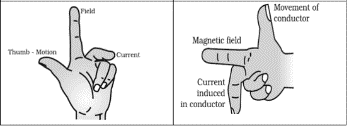For electric motors, Fleming’s left-hand rule is one of a pair of visual mnemonics, the other being Fleming’s right-hand rule (for generators).
When current runs through a conducting line and an external magnetic flux is placed across it, the running wire is less than the power associated with the field still flow direction). As seen in the figure, a left hand can be used to indicate three mutually orthogonal axes on the thumb, forefinger, and ring finger. After that, each finger is allocated to an amount (mechanical force, magnetic field and electric current). Generators and motors are operated with the right and left hands, respectively.
THEORY
The Fleming Left-Hand Rule and the Fleming Right-Hand Rule are fundamental magnetism and electromagnetism rules. They were invented in the late 1800s by John Ambrose Fleming as a simple technique of determining the direction of electrical charge in a power source or the direction of movement in an electric motor. It’s vital to note that these rules don’t define magnitude; rather, they demonstrate the direction of the three variables (magnetic field, current, and force) when the other two parameters’ directions are known.

What is the Right-Hand Rule
When a current goes through a magnetic flux, an electric current is induced in it, according to Faraday’s law of electromagnetic induction. The direction of the induced current is determined using Fleming’s right-hand rule.
According to Fleming’s Right Hand Rule, if we arrange our right hand’s thumb, forefinger, and middle finger perpendicular to one another, the thumb points to the direction of the conductor’s motion relative towards the magnetism, the forefinger points to the magnetic field, and the middle finger points to the induced current.
What is the Left-Hand Rule,
When a current-carrying conductor is exposed to an external magnetic field, it is subjected to a force that is perpendicular both to the field and the direction of the current flow. The direction of the force exerted on a current carrying conductor in a magnetic field is determined using Fleming’s left-hand rule.
According to Fleming’s Left Hand Rule, if we arrange our left-hand thumb, forefinger, and middle finger perpendicular to each other, the thumb points to the direction of the applied force experienced either by conductor, the forefinger to the direction of the magnetic field, and the middle finger to the position of the electric current.
DIFFERENCE BETWEEN FLEMING LEFT AND RIGHT HAND
Fleming left hand rule | Fleming right hand rule |
It is used in electric motors | It used for electric generators |
The rule’s aim is to determine the direction of motion of an electric motor. | When a coil rotates in a magnetic field, the rule is used to determine the direction of induced current. |
The direction of the Magnetic Dipole is represented by the index finger. | The direction of both the Magnetic Field is represented by the index finger. |
The current’s direction is represented by the middle finger. | The induced current is represented by the middle finger. |
The direction of something like the thrust here on the conductor is represented by the thumb. | The conductor’s direction of motion is represented by the thumb. |
The left-hand rule applies to motors, while the right-hand rule applies to generators. The left-hand rule and the right-hand rule are two visual mnemonics devised by Fleming (mnemonics are study techniques or memory aids, such as an abbreviation, rhyme ). In practice, these criteria are only employed to determine the direction of the consequent – either current or push – as a convenient gimmick. The Lorentz’ Force is what determines the magnitude of that force along the direction indicated by these principles.
CONCLUSION
For electric motors, Fleming’s left-hand rule is used, while for electric generators, Fleming’s right-hand eq is used. To put it another way, if you want to make motion, you should use Fleming’s left hand rule, whereas if you want to make electricity, you should use Fleming’s right hand rule. When a current goes through a magnetic flux, an electric current is induced in it, according to Faraday’s law of electromagnetic induction. When a current-carrying conductor is exposed to an external magnetic field, it is subjected to a force that is perpendicular both to field and the direction of the current flow.
 Profile
Profile Settings
Settings Refer your friends
Refer your friends Sign out
Sign out






